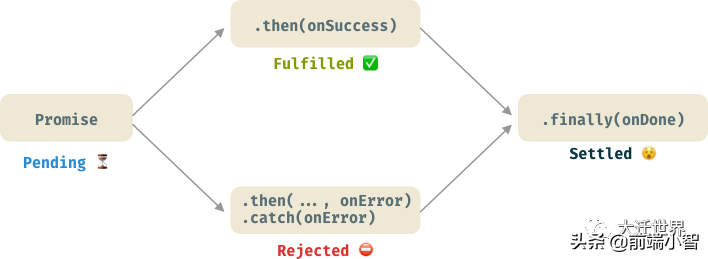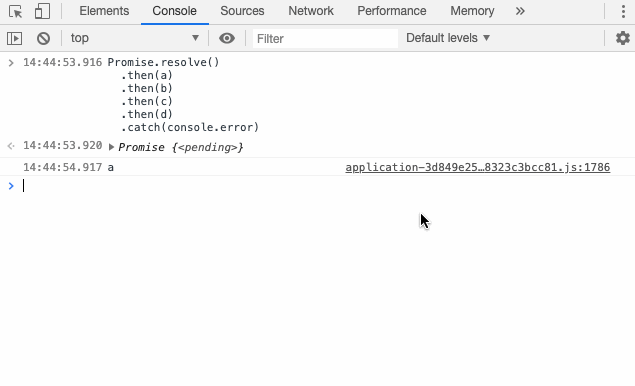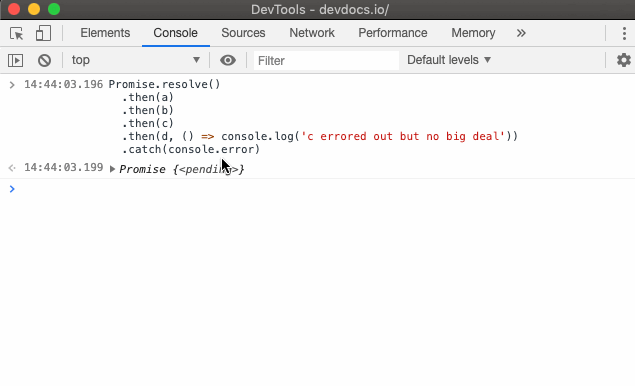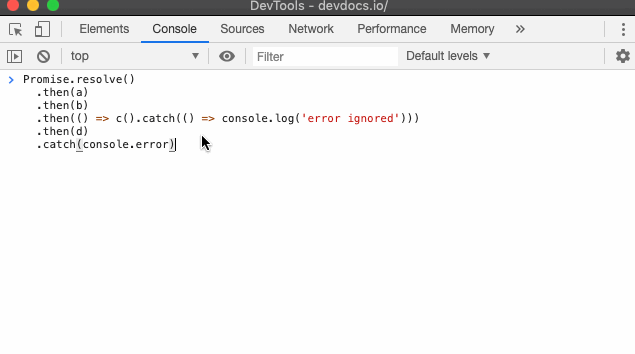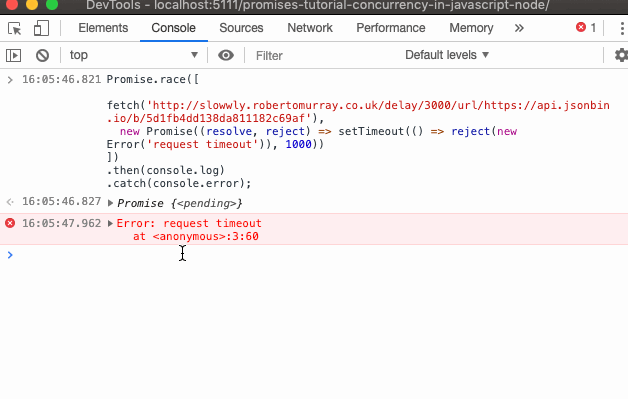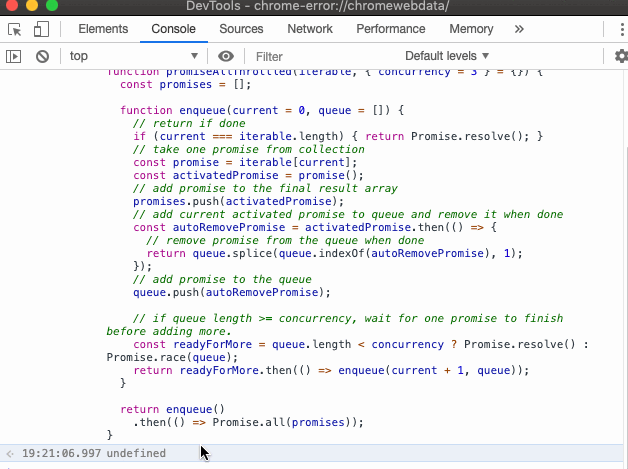1.JavaScript Promises
Promise 是一个允许我们处理异步操作的对象,它是 es5 早期回调的替代方法。
与回调相比,Promise 具有许多优点,例如:
让异步代码更易于阅读。
提供组合错误处理。* 更好的流程控制,可以让异步并行或串行执行。
回调更容易形成深度嵌套的结构(也称为回调地狱)。如下所示:
a(() => {
b(() => {
c(() => {
d(() => {
// and so on ...
}); }); });});
- 1.
- 2.
- 3.
- 4.
- 5.
- 6.
如果将这些函数转换为 Promise,则可以将它们链接起来以生成更可维护的代码。像这样:
Promise.resolve()
.then(a)
.then(b)
.then(c)
.then(d)
.catch(console.error);
- 1.
- 2.
- 3.
- 4.
- 5.
- 6.
在上面的示例中,Promise 对象公开了.then和.catch方法,我们稍后将探讨这些方法。
1.1 如何将现有的回调 API 转换为 Promise?
我们可以使用 Promise 构造函数将回调转换为 Promise。
Promise 构造函数接受一个回调,带有两个参数resolve和reject。
Resolve:是在异步操作完成时应调用的回调。
Reject:是发生错误时要调用的回调函数。
构造函数立即返回一个对象,即 Promise 实例。当在 promise 实例中使用.then方法时,可以在Promise “完成” 时得到通知。让我们来看一个例子。
Promise 仅仅只是回调?
并不是。承诺不仅仅是回调,但它们确实对.then和.catch方法使用了异步回调。Promise 是回调之上的抽象,我们可以链接多个异步操作并更优雅地处理错误。来看看它的实际效果。
Promise 反面模式(Promises 地狱)
a(() => {
b(() => {
c(() => {
d(() => {
// and so on ...
}); }); });});
- 1.
- 2.
- 3.
- 4.
- 5.
- 6.
不要将上面的回调转成下面的 Promise 形式:
a().then(() => {
return b().then(() => {
return c().then(() => {
return d().then(() =>{
// ⚠️ Please never ever do to this! ⚠️
}); }); });});
- 1.
- 2.
- 3.
- 4.
- 5.
- 6.
上面的转成,也形成了 Promise 地狱,千万不要这么转。相反,下面这样做会好点:
a()
.then(b)
.then(c)
.then(d)
- 1.
- 2.
- 3.
- 4.
超时
你认为以下程序的输出的是什么?
const promise = new Promise((resolve, reject) => {
setTimeout(() => {
resolve('time is up ⏰');
}, 1e3);
setTimeout(() => {
reject('Oops ');
}, 2e3);
});promise .then(console.log)
.catch(console.error);
- 1.
- 2.
- 3.
- 4.
- 5.
- 6.
- 7.
- 8.
- 9.
是输出:
time is up ⏰
Oops!
- 1.
- 2.
还是输出:
time is up ⏰
- 1.
是后者,因为当一个Promise resolved 后,它就不能再被rejected。
一旦你调用一种方法(resolve 或reject),另一种方法就会失效,因为 promise 处于稳定状态。让我们探索一个 promise 的所有不同状态。
1.2 Promise 状态
Promise 可以分为四个状态:
⏳ Pending:初始状态,异步操作仍在进行中。
✅ Fulfilled:操作成功,它调用.then回调,例如.then(onSuccess)。
⛔️ Rejected: 操作失败,它调用.catch或.then的第二个参数(如果有)。例如.catch(onError)或.then(..., onError)。
Settled:这是 promise 的最终状态。promise 已经死亡了,没有别的办法可以解决或拒绝了。.finally方法被调用
1.3 Promise 实例方法
Promise API 公开了三个主要方法:then,catch和finally。我们逐一配合事例探讨一下。
Promise then
then方法可以让异步操作成功或失败时得到通知。它包含两个参数,一个用于成功执行,另一个则在发生错误时使用。
promise.then(onSuccess, onError);
- 1.
你还可以使用catch来处理错误:
promise.then(onSuccess).catch(onError);
- 1.
Promise 链
then 返回一个新的 Promise ,这样就可以将多个Promise 链接在一起。就像下面的例子一样:
Promise.resolve()
.then(() => console.log('then#1'))
.then(() => console.log('then#2'))
.then(() => console.log('then#3'));
- 1.
- 2.
- 3.
- 4.
Promise.resolve立即将Promise 视为成功。因此,以下所有内容都将被调用。输出将是
then#1
then#2
then#3
- 1.
- 2.
- 3.
Promise catch
Promise .catch方法将函数作为参数处理错误。如果没有出错,则永远不会调用catch方法。
假设我们有以下承诺:1秒后解析或拒绝并打印出它们的字母。
const a = () => new Promise((resolve) => setTimeout(() => { console.log('a'), resolve() }, 1e3));
const b = () => new Promise((resolve) => setTimeout(() => { console.log('b'), resolve() }, 1e3));
const c = () => new Promise((resolve, reject) => setTimeout(() => { console.log('c'), reject('Oops!') }, 1e3));
const d = () => new Promise((resolve) => setTimeout(() => { console.log('d'), resolve() }, 1e3));
- 1.
- 2.
- 3.
- 4.
请注意,c使用reject('Oops!')模拟了拒绝。
Promise.resolve()
.then(a)
.then(b)
.then(c)
.then(d)
.catch(console.error)
- 1.
- 2.
- 3.
- 4.
- 5.
- 6.
输出如下:
在这种情况下,可以看到a,b和c上的错误消息。
我们可以使用then函数的第二个参数来处理错误。但是,请注意,catch将不再执行。
Promise.resolve()
.then(a)
.then(b)
.then(c)
.then(d, () => console.log('c errored out but no big deal'))
.catch(console.error)
- 1.
- 2.
- 3.
- 4.
- 5.
- 6.
由于我们正在处理 .then(..., onError)部分的错误,因此未调用catch。d不会被调用。如果要忽略错误并继续执行Promise链,可以在c上添加一个catch。像这样:
Promise.resolve()
.then(a)
.then(b)
.then(() => c().catch(() => console.log('error ignored')))
.then(d)
.catch(console.error)
- 1.
- 2.
- 3.
- 4.
- 5.
- 6.
当然,这种过早的捕获错误是不太好的,因为容易在调试过程中忽略一些潜在的问题。
Promise finally
finally方法只在 Promise 状态是 settled 时才会调用。
如果你希望一段代码即使出现错误始终都需要执行,那么可以在.catch之后使用.then。
Promise.resolve()
.then(a)
.then(b)
.then(c)
.then(d)
.catch(console.error)
.then(() => console.log('always called'));
- 1.
- 2.
- 3.
- 4.
- 5.
- 6.
- 7.
或者可以使用.finally关键字:
Promise.resolve()
.then(a)
.then(b)
.then(c)
.then(d)
.catch(console.error)
.finally(() => console.log('always called'));
- 1.
- 2.
- 3.
- 4.
- 5.
- 6.
- 7.
1.4 Promise 类方法
我们可以直接使用 Promise 对象中四种静态方法。
- Promise.all
- Promise.reject
- Promise.resolve
- Promise.race
Promise.resolve 和 Promise.reject
这两个是帮助函数,可以让 Promise 立即解决或拒绝。可以传递一个参数,作为下次 .then 的接收:
Promise.resolve('Yay!!!')
.then(console.log)
.catch(console.error)
- 1.
- 2.
- 3.
上面会输出 Yay!!!
Promise.reject('Oops ')
.then(console.log)
.catch(console.error)
- 1.
- 2.
- 3.
使用 Promise.all 并行执行多个 Promise
通常,Promise 是一个接一个地依次执行的,但是你也可以并行使用它们。
假设是从两个不同的api中轮询数据。如果它们不相关,我们可以使用Promise.all()同时触发这两个请求。
在此示例中,主要功能是将美元转换为欧元,我们有两个独立的 API 调用。一种用于BTC/USD,另一种用于获得EUR/USD。如你所料,两个 API 调用都可以并行调用。但是,我们需要一种方法来知道何时同时完成最终价格的计算。我们可以使用Promise.all,它通常在启动多个异步任务并发运行并为其结果创建承诺之后使用,以便人们可以等待所有任务完成。
const axios = require('axios');
const bitcoinPromise = axios.get('https://api.coinpaprika.com/v1/coins/btc-bitcoin/markets');
const dollarPromise = axios.get('https://api.exchangeratesapi.io/latest?base=USD');
const currency = 'EUR';
// Get the price of bitcoins on
Promise.all([bitcoinPromise, dollarPromise]) .then(([bitcoinMarkets, dollarExchanges]) => {
const byCoinbaseBtc = d => d.exchange_id === 'coinbase-pro' && d.pair === 'BTC/USD';
const coinbaseBtc = bitcoinMarkets.data.find(byCoinbaseBtc) const coinbaseBtcInUsd = coinbaseBtc.quotes.USD.price; const rate = dollarExchanges.data.rates[currency]; return rate * coinbaseBtcInUsd;
}) .then(price => console.log(`The Bitcoin in ${currency} is ${price.toLocaleString()}`))
.catch(console.log)
- 1.
- 2.
- 3.
- 4.
- 5.
- 6.
- 7.
- 8.
- 9.
- 10.
如你所见,Promise.all接受了一系列的 Promises。当两个请求的请求都完成后,我们就可以计算价格了。
我们再举一个例子:
const a = () => new Promise((resolve) => setTimeout(() => resolve('a'), 2000));
const b = () => new Promise((resolve) => setTimeout(() => resolve('b'), 1000));
const c = () => new Promise((resolve) => setTimeout(() => resolve('c'), 1000));
const d = () => new Promise((resolve) => setTimeout(() => resolve('d'), 1000));
console.time('promise.all');
Promise.all([a(), b(), c(), d()]) .then(results => console.log(`Done! ${results}`))
.catch(console.error)
.finally(() => console.timeEnd('promise.all'));
- 1.
- 2.
- 3.
- 4.
- 5.
- 6.
- 7.
- 8.
解决这些 Promise 要花多长时间?5秒?1秒?还是2秒?
这个留给你们自己验证咯。
Promise race
Promise.race(iterable) 方法返回一个 promise,一旦迭代器中的某个promise解决或拒绝,返回的 promise就会解决或拒绝。
const a = () => new Promise((resolve) => setTimeout(() => resolve('a'), 2000));
const b = () => new Promise((resolve) => setTimeout(() => resolve('b'), 1000));
const c = () => new Promise((resolve) => setTimeout(() => resolve('c'), 1000));
const d = () => new Promise((resolve) => setTimeout(() => resolve('d'), 1000));
console.time('promise.race');
Promise.race([a(), b(), c(), d()]) .then(results => console.log(`Done! ${results}`))
.catch(console.error)
.finally(() => console.timeEnd('promise.race'));
- 1.
- 2.
- 3.
- 4.
- 5.
- 6.
- 7.
- 8.
输出是什么?
输出 b。使用 Promise.race,最先执行完成就会结果最后的返回结果。
你可能会问:Promise.race的用途是什么?
我没胡经常使用它。但是,在某些情况下,它可以派上用场,比如计时请求或批量处理请求数组。
Promise.race([
fetch('http://slowwly.robertomurray.co.uk/delay/3000/url/https://api.jsonbin.io/b/5d1fb4dd138da811182c69af'),
new Promise((resolve, reject) => setTimeout(() => reject(new Error('request timeout')), 1000))
]).then(console.log)
.catch(console.error);
- 1.
- 2.
- 3.
- 4.
- 5.
如果请求足够快,那么就会得到请求的结果。
1.5 Promise 常见问题
串行执行 promise 并传递参数
这次,我们将对Node的fs使用promises API,并将两个文件连接起来:
const fs = require('fs').promises; // requires node v8+
fs.readFile('file.txt', 'utf8')
.then(content1 => fs.writeFile('output.txt', content1))
.then(() => fs.readFile('file2.txt', 'utf8'))
.then(content2 => fs.writeFile('output.txt', content2, { flag: 'a+' }))
.catch(error => console.log(error));
- 1.
- 2.
- 3.
- 4.
- 5.
- 6.
在此示例中,我们读取文件1并将其写入output 文件。稍后,我们读取文件2并将其再次附加到output文件。如你所见,writeFile promise返回文件的内容,你可以在下一个then子句中使用它。
如何链接多个条件承诺?
你可能想要跳过 Promise 链上的特定步骤。有两种方法可以做到这一点。
const a = () => new Promise((resolve) => setTimeout(() => { console.log('a'), resolve() }, 1e3));
const b = () => new Promise((resolve) => setTimeout(() => { console.log('b'), resolve() }, 2e3));
const c = () => new Promise((resolve) => setTimeout(() => { console.log('c'), resolve() }, 3e3));
const d = () => new Promise((resolve) => setTimeout(() => { console.log('d'), resolve() }, 4e3));
const shouldExecA = true;
const shouldExecB = false;
const shouldExecC = false;
const shouldExecD = true;
Promise.resolve() .then(() => shouldExecA && a())
.then(() => shouldExecB && b())
.then(() => shouldExecC && c())
.then(() => shouldExecD && d())
.then(() => console.log('done'))
- 1.
- 2.
- 3.
- 4.
- 5.
- 6.
- 7.
- 8.
- 9.
- 10.
- 11.
- 12.
- 13.
如果你运行该代码示例,你会注意到只有a和d被按预期执行。
另一种方法是创建一个链,然后仅在以下情况下添加它们:
const chain = Promise.resolve();
if (shouldExecA) chain = chain.then(a);
if (shouldExecB) chain = chain.then(b);
if (shouldExecC) chain = chain.then(c);
if (shouldExecD) chain = chain.then(d);
chain .then(() => console.log('done'));
- 1.
- 2.
- 3.
- 4.
- 5.
- 6.
如何限制并行 Promise?
要做到这一点,我们需要以某种方式限制Promise.all。
假设你有许多并发请求要执行。如果使用 Promise.all 是不好的(特别是在API受到速率限制时)。因此,我们需要一个方法来限制 Promise 个数, 我们称其为promiseAllThrottled。
// simulate 10 async tasks that takes 5 seconds to complete.
const requests = Array(10)
.fill() .map((_, i) => () => new Promise((resolve => setTimeout(() => { console.log(`exec'ing task #${i}`), resolve(`task #${i}`); }, 5000))));
promiseAllThrottled(requests, { concurrency: 3 })
.then(console.log)
.catch(error => console.error('Oops something went wrong', error));
- 1.
- 2.
- 3.
- 4.
- 5.
- 6.
输出应该是这样的:
以上代码将并发限制为并行执行的3个任务。
实现promiseAllThrottled 一种方法是使用Promise.race来限制给定时间的活动任务数量。
/**
* Similar to Promise.all but a concurrency limit
*
* @param {Array} iterable Array of functions that returns a promise
* @param {Object} concurrency max number of parallel promises running
*/
function promiseAllThrottled(iterable, { concurrency = 3 } = {}) {
const promises = [];
function enqueue(current = 0, queue = []) {
// return if done
if (current === iterable.length) { return Promise.resolve(); }
// take one promise from collection
const promise = iterable[current];
const activatedPromise = promise();
// add promise to the final result array
promises.push(activatedPromise);
// add current activated promise to queue and remove it when done
const autoRemovePromise = activatedPromise.then(() => {
// remove promise from the queue when done
return queue.splice(queue.indexOf(autoRemovePromise), 1);
});
// add promise to the queue
queue.push(autoRemovePromise);
// if queue length >= concurrency, wait for one promise to finish before adding more.
const readyForMore = queue.length < concurrency ? Promise.resolve() : Promise.race(queue);
return readyForMore.then(() => enqueue(current + 1, queue));
}
return enqueue()
.then(() => Promise.all(promises));
}
- 1.
- 2.
- 3.
- 4.
- 5.
- 6.
- 7.
- 8.
- 9.
- 10.
- 11.
- 12.
- 13.
- 14.
- 15.
- 16.
- 17.
- 18.
- 19.
- 20.
- 21.
- 22.
- 23.
- 24.
- 25.
- 26.
- 27.
- 28.
- 29.
- 30.
promiseAllThrottled一对一地处理 Promises 。它执行Promises并将其添加到队列中。如果队列小于并发限制,它将继续添加到队列中。达到限制后,我们使用Promise.race等待一个承诺完成,因此可以将其替换为新的承诺。这里的技巧是,promise 自动完成后会自动从队列中删除。另外,我们使用 race 来检测promise 何时完成,并添加新的 promise 。














